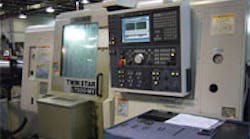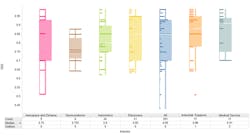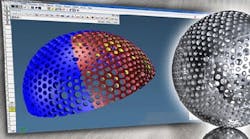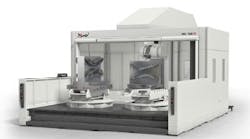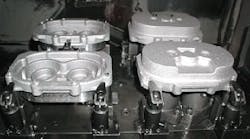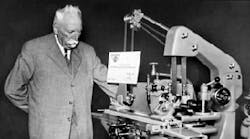John Skalicki always wondered why there weren’t more machine tools with PC-based controls on them.
As the products operations manager at Fluid Line Products (www.fluidline. com) in Willoughby, Ohio, he realized the benefits such controls could offer in terms of machine networking and software integration. However, when it came time to replace some outdated equipment, he struggled to find a supplier who offered machines with true PC-based controls, until he found the P100 THINC-OSP Microsoft Windows and PC-based control.
The control comes from Okuma America Corp. (www.okuma.com), and was a key selling feature for Skalicki when his shop purchased one of Okuma’s LT 200 multi-functional turning machines. Skalicki’s shop designs and manufactures fittings and valves.
Besides producing 9 percent more parts each day compared with Fluid Line Products’ other equipment, the LT 200 with the THINC-OSP control lets the shop transfer part programs from its main database to the machine without having to feed them over RS232 cables then having to hand signal machine operators across the shop during the transfer. Also, backing up and saving programs is done easily by transferring them from the machine’s hard drive to the shop’s network, again without the need to use RS232 cable.
Three weeks after Fluid Line Products received its machine, it determined that the THINC-OSP control required some software updates. Okuma connected to the control through the Internet, and accessed Fluid Line Products’ desktop. Okuma made that connection with Fluid Line Products’ permission.
“We watched from the control screen as engineers in Okuma’s North Carolina facility searched our registry and updated a lot of our files. That was the first time I’d ever seen that done,” Skalicki said. In addition, the ability to connect remotely allows Okuma to perform diagnostic services, saving potential service calls and even more costly downtime.
As another plus, Fluid Line machine operators can add production data into the THINC-OSP’s software at the machine to provide real-time information. Skalicki then can view machine status from his desk, and operators no longer have to walk to and from another standalone computer station to input their production data.
According to Bob Tain, director of CNC controls at Okuma America, the THINC-OSP control is different from other PC-based controls in that it encompasses a companywide vision to provide a machine tool control to allow individual shops, or anyone with some understanding of computers, to modify the control to their specific needs.
What makes this possible is the control’s single-processor platform and open application programming interfaces that facilitate communication between systems. These interfaces, which Okuma made open to programmers, let the THINC-OSP control draw information out of, or push it into, the real-time operating system. With this type of control platform, shops can add software applications to the control on their own.
“It is a true compatible PC. We have yet to find a piece of software that will run on a desktop or laptop computer that will not run in the THINC-OSP control. And that is not always the case with other PC-based controls,” Tain said.
Tain also said that the Thinc control makes machine tools more autonomous, and he offered this example: With an Okuma machine equipped with a THINC-OSP control, a shop can connect a USB-based, post-processing external gauging system and load an SPC software package into the control. As part sizes change during machining, because of such factors as tool wear, the external gauging system sends that data, via the application programming interfaces, to the THINC-OSP control. In turn, the control adjusts the cutting tool’s offset to compensate for the real-time changes.
Using conventional controls in the same scenario, a shop would need an external PC next to its machine to run additional software applications such as the SPC package. In addition, it would have to purchase an interface between the standalone PC and the machine CNC , and it would still have to manually change data in the machine, and that could increase the risk of human error.
Because it is based on a single-processor, Okuma can update its THINC-OSP control easily to grow with developing technology and new software. Shops gain access to applications and peripherals that can be considered endless, including factory management systems and interfaces with bar coders, feeders, robots, probes and tool setters to streamline production.
“The THINC-OSP control is an intelligent platform that truly learns by way of adding new software,” commented Tain. And it retrofits to most existing Okuma machines. Whether or not the retrofit involves also changing motors and drives depends on the intended machine’s age.
Experimenting with the THINC-OSP control and additional third-party software has opened the door to many possibilities, according to Skalicki. "You are only limited by your imagination regarding what you can do with the control. I think it is hard to imagine the possibilities untill you have that opportunity in front of you," he said.
| Thinc partners | |
| Shops can customize the THINC-OSP control on their own, and Okuma has partnered with third-party companies (THINC Partnership) that also can plug their applications into the control. However, applications can come from any source, not just partnership companies. | |
| Wilcox & Associates | |
| Caron Engineering | Kennametal |
| Zoller | Schunk Inc. |
| Sandvik | LNS America Inc. |
| Extrude Hone | Midaco Corp. |
| Trend Micro | Infinity Rebuild |
| Brown & Sharpe | Marposs Corp. |
| ABB -Auburn Hills | ChipBlaster Inc. |
| Fanuc Robotics America Inc. | Webex |
| Exact software-JobBoss | Renishaw |
| BigFix | Zeiss |
| Symantec | Blum Lmt. Inc. |
| Gosiger Inc. | Iscar Metals |
| Marposs Corp. | Shell Lubricants |
| Wilcox & Associates | |
